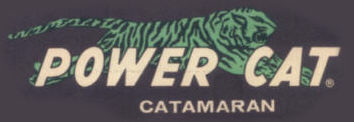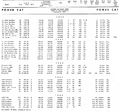Difference between revisions of "Power Cat"
(added link to Avenger, Mercury, fixed boats in use link) |
|||
| (6 intermediate revisions by 3 users not shown) | |||
| Line 37: | Line 37: | ||
models were only made in fiberglass. | models were only made in fiberglass. | ||
<br><br> | <br><br> | ||
| − | Mercury Marine had a unique relationship with PowerCat. PowerCat furnished | + | [[Mercury|Mercury Marine]] had a unique relationship with PowerCat. PowerCat furnished |
Mercury with boats for test beds for their use at Lake X and many factory | Mercury with boats for test beds for their use at Lake X and many factory | ||
sponsored race teams ran Mercury motors. In return Mercury furnished | sponsored race teams ran Mercury motors. In return Mercury furnished | ||
| Line 56: | Line 56: | ||
to Victoria, Texas in 1962. This allowed the company to shipping boats to | to Victoria, Texas in 1962. This allowed the company to shipping boats to | ||
dealers and customers all over the country from one central location. | dealers and customers all over the country from one central location. | ||
| − | Closing the Bellflower California plant was a logical choice, but many of | + | Closing the Bellflower, California plant was a logical choice, but many of |
the people who had worked for the company in California decided not to make | the people who had worked for the company in California decided not to make | ||
the move to Texas. One was Ray Leger's half brother Bobby Brown had been | the move to Texas. One was Ray Leger's half brother Bobby Brown had been | ||
| Line 62: | Line 62: | ||
was proving to be an excellent drag/ski boat. Ray made an agreement to give | was proving to be an excellent drag/ski boat. Ray made an agreement to give | ||
a set of the molds to Bobby and he formed his own company called "CeeBee | a set of the molds to Bobby and he formed his own company called "CeeBee | ||
| − | Mfg. Co." and producing the Hydro under the name Avenger Boat Co. PowerCat | + | Mfg. Co." and producing the Hydro under the name [[Avenger|Avenger Boat Co.]] PowerCat |
then would not market that product on the west Coast, and Avenger went on to | then would not market that product on the west Coast, and Avenger went on to | ||
develop many designs of its own! | develop many designs of its own! | ||
| Line 87: | Line 87: | ||
<br><br> | <br><br> | ||
| − | |||
| − | + | '''Misc. Info''' | |
| + | <gallery> | ||
| + | File:Powercatb001.jpg | Misc. Brochure | ||
| + | File:Powercatbb001.jpg|1958 to 1962 Power Cat models | ||
| + | </gallery> | ||
| − | |||
'''1958 Info''' | '''1958 Info''' | ||
| Line 99: | Line 101: | ||
File:Powercatb58003.jpg | 1958 Brochure p3 | File:Powercatb58003.jpg | 1958 Brochure p3 | ||
File:Powercatb58004.jpg | 1958 Brochure p4 | File:Powercatb58004.jpg | 1958 Brochure p4 | ||
| + | File:BHBPHOTO12.JPG | 1958 Power Cat Ocelot test | ||
| + | File:BHBPHOTO13.JPG | 1958 Mercury Boathouse Bulletin | ||
| + | File:BHBPHOTO14.JPG | 1958 MeBoathouse Bulletin | ||
</gallery> | </gallery> | ||
| + | |||
'''1959 Info''' | '''1959 Info''' | ||
| Line 107: | Line 113: | ||
File:Powercatb59003.jpg | 1959 Brochure p3 | File:Powercatb59003.jpg | 1959 Brochure p3 | ||
File:Powercatb59004.jpg | 1959 Brochure p4 | File:Powercatb59004.jpg | 1959 Brochure p4 | ||
| + | File:Mercurya59001.jpg | Power Cat boat in a 1959 Mercury Ad | ||
</gallery> | </gallery> | ||
| + | |||
'''1960 Info''' | '''1960 Info''' | ||
| Line 115: | Line 123: | ||
File:Powercatb60003.jpg | 1960 Brochure p3 | File:Powercatb60003.jpg | 1960 Brochure p3 | ||
</gallery> | </gallery> | ||
| + | |||
'''1961 Info''' | '''1961 Info''' | ||
| Line 123: | Line 132: | ||
File:Powercatb61004.jpg | 1961 Brochure p4 | File:Powercatb61004.jpg | 1961 Brochure p4 | ||
</gallery> | </gallery> | ||
| + | |||
'''1964 Info''' | '''1964 Info''' | ||
| Line 139: | Line 149: | ||
File:Powercatb64012.jpg | 1964 Brochure p12 | File:Powercatb64012.jpg | 1964 Brochure p12 | ||
</gallery> | </gallery> | ||
| + | |||
| + | |||
| + | [http://www.fiberglassics.com/index.php?searchword=Power+Cat&ordering=newest&searchphrase=exact&limit=20&Itemid=88&option=com_search Power Cat Boats in Use] | ||
| + | |||
| + | |||
| + | External Links: | ||
| + | [http://www.powercatboat.com Resources for Power Cat Boat Owner's] | ||
[[Main_Page|Back to Main Page]] | [[Main_Page|Back to Main Page]] | ||
| + | |||
| + | [[Category:California]] | ||
| + | [[Category:Sheet Plywood]] | ||
| + | [[Category:Fiberglass]] | ||
| + | [[Category:Catamarans]] | ||
| + | [[Category:Texas]] | ||
Latest revision as of 18:32, 11 November 2012
Power Cat Boat Corp. of Bellflower, California originally started building
wooden boats as a small division of "Paramount Wood Products" a specialty
company started by Ray Leger for the production of wood sash and doors to
serve the exploding housing market in post WWII Southern California.
Ray and many of his fellow employees were friends during W.W.II working for
a boat yard in San Pedro that made PT and PBY boats for the military. This
gave many of them the key skills of carpentry and boat construction that
soon would be put to use.
The idea for the one of the earliest "Powered Catamaran" was due in part to
the fact that Ray's wife Evelyn enjoyed offshore fishing but was very prone
to seasickness. The catamaran's being more stable in the water made them
rock less and this was the supposed reason for the first powered catamaran
made by Ray Leger. This idea and many other influences were brought together
in the original design. It needed to be reliable and roomy enough yet still
be capable of being transported on a trailer rather than require a berth for
storage. The twin outboards were expensive yet would give the security of
having 2 motors in case one failed. The very first PowerCat was an 18 ft
cabin cruiser that ran twin Scott Atwater 33 hp outboards. The boat was a
resounding success and it started a whole revolution!
The early company focused its efforts on the production of plywood
Catamarans Sometime beginning in the early 1950's. All PowerCat boats built
through 1972 were the inspirations and brainchild of master boat builder and
designer Ray Leger. His designs ran the full gamete from Catamarans,
Tri-hull's, Hydro's and Bass boats.
We should note that all the earlier plywood Catamarans featured the
application of fabulous tail fins but evidently with the transition to
fiberglass construction, (beginning in 1958) the fins were significantly
reduced in size, and then phased out all together in the early to mid 60's.
PowerCat Boat Corp. regularly produced hulls from 12 ft. to 28 ft. although
some custom 30's and 40's footers were also built.
The switch to fiberglass in started in 1958 and by 1962 all production
models were only made in fiberglass.
Mercury Marine had a unique relationship with PowerCat. PowerCat furnished
Mercury with boats for test beds for their use at Lake X and many factory
sponsored race teams ran Mercury motors. In return Mercury furnished
PowerCat with the latest in motors for use in their factory racing efforts.
Part of the arrangement was that the motors and boats were returned to their
respective factories after they were no longer usable for evaluation for
ware and component failures. This relationship helped both PowerCat and
Mercury to refine their product lines.
A lot of non-factory sponsored teams also ran PowerCat's, but it was
Mercury's exploits with PowerCats that evidently lead to an advertising
bonanza! By winning most of the key open water and endurance races in the
late 50's and early 60's PowerCat won the reputation as true airborne Hot
Rod of boats.
In an effort to shorten shipping time and better support its ever-expanding
market, the company centralized its operations and manufacturing facilities
to Victoria, Texas in 1962. This allowed the company to shipping boats to
dealers and customers all over the country from one central location.
Closing the Bellflower, California plant was a logical choice, but many of
the people who had worked for the company in California decided not to make
the move to Texas. One was Ray Leger's half brother Bobby Brown had been
instrumental in the development of the new three point hydro design, which
was proving to be an excellent drag/ski boat. Ray made an agreement to give
a set of the molds to Bobby and he formed his own company called "CeeBee
Mfg. Co." and producing the Hydro under the name Avenger Boat Co. PowerCat
then would not market that product on the west Coast, and Avenger went on to
develop many designs of its own!
PowerCat from its new home base in Texas was at the highest level of
production the company had seen. The mid 60's saw the primary product
shifting to the development of Tri-hulls. The new Tri-hull was an adaptation
from the original catamaran designs that facilitated the better use of a
single engine. Due to the rising costs of fuel and greatly improved engine
reliability, catamarans were becoming harder to sell. By the late 60's
Catamarans had been phased out of production.
In 1966 Fire completely destroyed the Victoria, Texas plant. The company was
quickly restructured, and emerged from the ashes with new investors and was
now known as the " Powercat of Texas Corp.". Soon thereafter the company's
main product line was a popular line of Bass boats and Tri-hulls.
Ray Leger sold his interest in the company in 1972.
Classic PowerCat boats can still be seen today running around on local lakes
and Open waters ways being pushed by a wide verity of outboards old and new!
Misc. Info
1958 Info
1959 Info
1960 Info
1961 Info
1964 Info
External Links:
Resources for Power Cat Boat Owner's

































